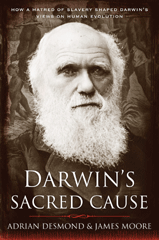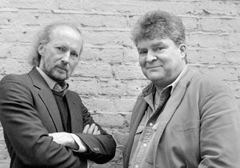Darwin the Abolitionist
Air Date: Week of February 6, 2009

(Courtesy of Houghton Mifflin Harcourt)
Two-hundred years after his birth, a new biography sets out to portray Charles Darwin as a passionate moralist engaged in a scientific war on the prevailing racism of the day. James Moore, author of "Darwin's Sacred Cause," talks with host Bruce Gellerman about how the scream of a tortured slave drove Darwin to develop his theory of evolution—and helped discount the scientifically-accepted belief that blacks and whites belonged to different species.
Transcript
GELLERMAN: This month we commemorate the 200th birthday of British naturalist; Charles Darwin. It’s said, Darwin came up with “the single best idea anyone ever had”. He published it in 1859 in his book: On the Origin of Species. Darwin’s unexpectedly popular and controversial idea was that all species of life evolved over time from common ancestors. Darwin’s theory of that process, natural selection, changed the world of science and society at large.
But even today the laws of nature Darwin discovered are still hotly debated and we continue to learn more about the social origins and scientific evolution of Charles Darwin himself. James Moore is co-author of the new book "Darwin's Sacred Cause: How a Hatred of Slavery Shaped Darwin's Views on Human Evolution."
MOORE: All science begins with certain assumptions about the world. Darwin began with certain assumptions. He believed in history. He believed that everything happened slowly, everything happens by natural law. These were first principles, these were given for Darwin. Another given for Darwin was that all the races are members of the same family. This was ingrained in him from childhood. And it’s what led him to theorize about the common descent of all life.

Darwin biographers Adrian Desmond (left) and James Moore. (Photo: (c) Justine Stoddart)
MOORE: Yes, it does. Both Darwin’s grandfathers were passionately committed to abolishing the slave trade, which flourished in that time. And in 1807, two years before Darwin was born, Parliament did abolish trans-Atlantic slave trade. And in America the trans-Atlantic slave trade was outlawed a year later. So Darwin was born into a world in which half the battle had been won. But the slaves remained to be emancipated. And to that end different societies sprang up all of them supported by Darwin’s family.
GELLERMAN: But it’s not until he takes this trip aboard the Beagle that he’s confronted directly with what slave trade really means.
MOORE: Until Darwin reached South America, he had a theoretical understanding of slavery and it’s horrors, but when he got to South America, he put shredded flesh on that slave. He saw the instruments of torture. He heard the screams. And suddenly he became fired as never before that this sin, he called it, should be abolished around the world
GELLERMAN: And from there Darwin sees the horrors of slavery revealed as the trip progresses.
MOORE: He does, you know, outstandingly in Brazil. It’s seared into him. He sees the remnants of slavery and the flotsam of slavery. And at the very end of the voyage, just weeks before the Beagle reaches England, they touch back again in Brazil, and it’s there that Darwin’s walking past a house on the other side of the wall, he hears shrieks and screams, and he thinks to himself, that can only be a slave being tortured. And he was powerless to do anything about it. And when the Beagle got back to Britain, within a few months, he had, within his private notebooks declared himself a believer in common descent of all life.
GELLERMAN: Professor Moore do you think the echo of that scream was as important for what was to come many years later in Darwin’s theory as the species that he collected on his voyager of the Beagle?
MOORE: The scream that stayed with Darwin for life did as much as anything to kick start his belief in the evolution of all life, the common descent of all life. Without the evidence of the Galapagos, we wouldn’t have an argument for evolution by natural selection. But why he went to the trouble and the risk of assembling that evidence and in the way that he did, to understand that we need a deeper explanation. He didn’t collect facts, as they were called, at random. There was a reason for what he did. And his reason had precedence in his own experience and his own family. The scream of a tortured slave, fired him to touch the untouchable and to develop what he called “my theory,” the theory of evolution.
GELLERMAN: I wonder if you might read something from your book. It’s on page 182, and it’s where he’s trading letters with the professor who had been his mentor, in England, Professor Lyle.
MOORE: Oh yes. His greatest eruption ever in print. An absolute moral bombshell he drops in his journal researches about the Beagle voyage: “Those who look tenderly at the slave owner and with a cold heart at the slave, never seem to put themselves into the position of that later. What a cheerless prospect with not even a hope of change. Picture yourself the chance ever hanging over you of your wife and your little children, those objects which nature urges even the slave to call his own, being torn from you and sold like beasts to the first bidder. And these deeds are done and palliated by men who profess to love their neighbors as themselves, who believe in God and pray that his will be done on Earth. It makes one’s blood boil, yet I tremble to think that we Englishmen and our American descendents with their boastful cry of liberty have been and are so guilty.”

(Courtesy of Houghton Mifflin Harcourt)
GELLERMAN: Kind of interesting that at the time that science was used to sustain slavery.
MOORE: Science wasn’t just used to sustain slavery, science was constructed and formulated in such a way that it kept the races together or apart. People had recognized difference amongst themselves from time immemorial. In Darwin’s day, the notion of separate races, separate types of human being, separately created types of human being was claimed to be put on a scientific basis, mainly by measuring people’s bodies.
GELLERMAN: You write a lot about how they would kind of feel the bumps on your head to be able …
MOORE: That’s the proximate source of it, yes, yes. And Darwin in Edinburgh - when he was a student in his teens at Edinburgh University - phrenology, measuring bumps on people’s heads in order to determine their propensities and their character - was absolutely rife. It was a parlor sport, it was also serious science. And in the United States in the 1840s and 1850s, this was considered to be the best progressive, positive science. And Darwin stood foursquare against that movement. All his research in the 1850s was devoted to undermining something that people thought was the latest science.
GELLERMAN: It pits him directly with some of the big wigs in science, particularly in the United States. At Harvard there was Professor Agassiz who’s really a giant. We’re not far from Harvard University right here from our studios and many things are named after him. And Agassiz is really Darwin’s great nemesis.
MOORE: Louie Agassiz was the great popularizer of science in Darwin’s day. He had a fabulous influence. He had an influence in Washington and from Harvard across the country and Agassiz believed that a strong creationist America had to resist the amalgamation of black people with white people because God had created them separately, they must not be brought together. And it frankly revolted him. With all of the authority and prestige of Harvard University, Agassiz maintained this throughout his career there.
GELLERMAN: So the key to debunking the scientific racism of the day was sexual selection. This is during the Victorian era we should say. How did Darwin come up with this theory?
MOORE: Darwin had a theory like no one else had to explain the divergence of the human races, why we look so different to each other. Why some people have very dark skin and others very light, and their eyes are differently shaped and thick lips or thin lips and curly hair or straight hair. All of these things Darwin saw as beauty marks that arose from selection we make in our sexual partners, he calls it sexual selection. You choose people you think are beautiful, and if you choose a man or a woman with particular physical characteristics and have children by that person, the children will resemble the parents. And Darwin says this is exactly what goes on in the breeding of fancy animals.
GELLERMAN: Well he was born 200 years ago. Happy birthday, Charles Darwin. What would you say to him if he were around now?
MOORE: Oh that’s a hard one isn’t it? I would remind him of a statement he made towards the end of his life when asked whether in the progress of mankind we might all become immortal. And he said he thought it very unlikely because if nothing ever died, there wouldn’t be any life at all.
GELLERMAN: Well Professor Moore, it’s been a great pleasure. I really appreciate it.
MOORE: I have enjoyed it too. Thank you so much.
GELLERMAN: James Moore and co-author Adrian Desmond’s new book is Darwin's Sacred Cause.
Links
Living on Earth wants to hear from you!
Living on Earth
62 Calef Highway, Suite 212
Lee, NH 03861
Telephone: 617-287-4121
E-mail: comments@loe.org
Newsletter [Click here]
Donate to Living on Earth!
Living on Earth is an independent media program and relies entirely on contributions from listeners and institutions supporting public service. Please donate now to preserve an independent environmental voice.
NewsletterLiving on Earth offers a weekly delivery of the show's rundown to your mailbox. Sign up for our newsletter today!
 Sailors For The Sea: Be the change you want to sea.
Sailors For The Sea: Be the change you want to sea.
 The Grantham Foundation for the Protection of the Environment: Committed to protecting and improving the health of the global environment.
The Grantham Foundation for the Protection of the Environment: Committed to protecting and improving the health of the global environment.
 Contribute to Living on Earth and receive, as our gift to you, an archival print of one of Mark Seth Lender's extraordinary wildlife photographs. Follow the link to see Mark's current collection of photographs.
Contribute to Living on Earth and receive, as our gift to you, an archival print of one of Mark Seth Lender's extraordinary wildlife photographs. Follow the link to see Mark's current collection of photographs.
 Buy a signed copy of Mark Seth Lender's book Smeagull the Seagull & support Living on Earth
Buy a signed copy of Mark Seth Lender's book Smeagull the Seagull & support Living on Earth

